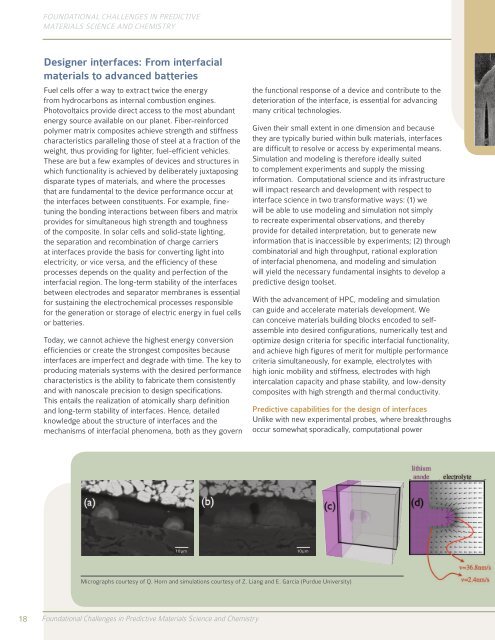Computational Materials Science and Chemistry ... - Office of Science
Computational Materials Science and Chemistry ... - Office of Science
Computational Materials Science and Chemistry ... - Office of Science
You also want an ePaper? Increase the reach of your titles
YUMPU automatically turns print PDFs into web optimized ePapers that Google loves.
FOUNDATIONAL CHALLENGES IN PREDICTIVE<br />
MATERIALS SCIENCE AND CHEMISTRY<br />
Designer interfaces: From interfacial<br />
materials to advanced batteries<br />
Fuel cells <strong>of</strong>fer a way to extract twice the energy<br />
from hydrocarbons as internal combustion engines.<br />
Photovoltaics provide direct access to the most abundant<br />
energy source available on our planet. Fiber-reinforced<br />
polymer matrix composites achieve strength <strong>and</strong> stiffness<br />
characteristics paralleling those <strong>of</strong> steel at a fraction <strong>of</strong> the<br />
weight, thus providing for lighter, fuel-efficient vehicles.<br />
These are but a few examples <strong>of</strong> devices <strong>and</strong> structures in<br />
which functionality is achieved by deliberately juxtaposing<br />
disparate types <strong>of</strong> materials, <strong>and</strong> where the processes<br />
that are fundamental to the device performance occur at<br />
the interfaces between constituents. For example, finetuning<br />
the bonding interactions between fibers <strong>and</strong> matrix<br />
provides for simultaneous high strength <strong>and</strong> toughness<br />
<strong>of</strong> the composite. In solar cells <strong>and</strong> solid-state lighting,<br />
the separation <strong>and</strong> recombination <strong>of</strong> charge carriers<br />
at interfaces provide the basis for converting light into<br />
electricity, or vice versa, <strong>and</strong> the efficiency <strong>of</strong> these<br />
processes depends on the quality <strong>and</strong> perfection <strong>of</strong> the<br />
interfacial region. The long-term stability <strong>of</strong> the interfaces<br />
between electrodes <strong>and</strong> separator membranes is essential<br />
for sustaining the electrochemical processes responsible<br />
for the generation or storage <strong>of</strong> electric energy in fuel cells<br />
or batteries.<br />
Today, we cannot achieve the highest energy conversion<br />
efficiencies or create the strongest composites because<br />
interfaces are imperfect <strong>and</strong> degrade with time. The key to<br />
producing materials systems with the desired performance<br />
characteristics is the ability to fabricate them consistently<br />
<strong>and</strong> with nanoscale precision to design specifications.<br />
This entails the realization <strong>of</strong> atomically sharp definition<br />
<strong>and</strong> long-term stability <strong>of</strong> interfaces. Hence, detailed<br />
knowledge about the structure <strong>of</strong> interfaces <strong>and</strong> the<br />
mechanisms <strong>of</strong> interfacial phenomena, both as they govern<br />
10µm 10µm<br />
the functional response <strong>of</strong> a device <strong>and</strong> contribute to the<br />
deterioration <strong>of</strong> the interface, is essential for advancing<br />
many critical technologies.<br />
Given their small extent in one dimension <strong>and</strong> because<br />
they are typically buried within bulk materials, interfaces<br />
are difficult to resolve or access by experimental means.<br />
Simulation <strong>and</strong> modeling is therefore ideally suited<br />
to complement experiments <strong>and</strong> supply the missing<br />
information. <strong>Computational</strong> science <strong>and</strong> its infrastructure<br />
will impact research <strong>and</strong> development with respect to<br />
interface science in two transformative ways: (1) we<br />
will be able to use modeling <strong>and</strong> simulation not simply<br />
to recreate experimental observations, <strong>and</strong> thereby<br />
provide for detailed interpretation, but to generate new<br />
information that is inaccessible by experiments; (2) through<br />
combinatorial <strong>and</strong> high throughput, rational exploration<br />
<strong>of</strong> interfacial phenomena, <strong>and</strong> modeling <strong>and</strong> simulation<br />
will yield the necessary fundamental insights to develop a<br />
predictive design toolset.<br />
With the advancement <strong>of</strong> HPC, modeling <strong>and</strong> simulation<br />
can guide <strong>and</strong> accelerate materials development. We<br />
can conceive materials building blocks encoded to selfassemble<br />
into desired configurations, numerically test <strong>and</strong><br />
optimize design criteria for specific interfacial functionality,<br />
<strong>and</strong> achieve high figures <strong>of</strong> merit for multiple performance<br />
criteria simultaneously, for example, electrolytes with<br />
high ionic mobility <strong>and</strong> stiffness, electrodes with high<br />
intercalation capacity <strong>and</strong> phase stability, <strong>and</strong> low-density<br />
composites with high strength <strong>and</strong> thermal conductivity.<br />
Micrographs courtesy <strong>of</strong> Q. Horn <strong>and</strong> simulations courtesy <strong>of</strong> Z. Liang <strong>and</strong> E. Garcia (Purdue University)<br />
18 Foundational Challenges in Predictive <strong>Materials</strong> <strong>Science</strong> <strong>and</strong> <strong>Chemistry</strong><br />
Predictive capabilities for the design <strong>of</strong> interfaces<br />
Unlike with new experimental probes, where breakthroughs<br />
occur somewhat sporadically, computational power

















